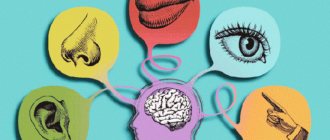What are sensations? To talk about sensations means to refer to the human body and all its nerve endings that help us get in touch with the world inside us and the world outside us.
Various types of sensations refer to the basic direct experiences caused by simple isolated stimuli. Sensation is also defined as the response of the sense organs to a stimulus. These are conscious captures of the properties of objects, things and phenomena.
Sensation is only the first stage of cognition, which through thought transforms data into ideas, concepts, laws, etc. And those, in turn, more deeply reflect the objective world and the accuracy of which is verified by practice. A sensation occurs when a stimulus impacts a receptor.
Although the concepts of sensation and perception are often used interchangeably, they differ in many details.
Sensation is the experience experienced by a stimulus in the form of a response to a sensory experiment, while perception is the interpretation of sensation that gives meaning and order.
Definition
Sensation is a spontaneous mental phenomenon that arises as a result of the direct influence of things of the objective world on the sense organs (analyzers) of animals and humans, an influence that is subjectively felt as the quality of the things themselves (red, cold, prickly, etc.). Sensation is secondary to material reality.
The term sensation has several meanings, for example it can refer to the impression that an object makes through the senses, that is, it becomes the immediate response of the sense organs when they receive a stimulus.
It also alludes to the surprise effect that people have when they are surprised by something or someone. Another definition refers to an intuition or feeling that an event or problem may occur to a person.
Sensation involves the optimal functioning of the senses and nervous system, and under normal conditions it results in what we can see, for example, red when it is red and green when it is green.
Physiological mechanisms and patterns of sensations
In the process of the emergence of sensations, two parties are involved: the irritant that affects the body, and the analyzers that perceive this irritation. Sensation is not a passive reflection, but an active process during which all parts of the analyzer work together.
The analyzer is a part of the nervous system that has the ability to distinguish between the effects of external stimuli. It consists of three parts :
- Receptors are nerve endings located in the sense organs, which are characterized by a lower threshold of irritability with increased sensitivity to the stimuli themselves. This allows the receptors to respond to even the smallest impacts and reflect the excessive impact of the stimulus on the body. There are two types of receptors: exteroceptors (process information coming from the outside world) and interoceptors (process information coming from the body itself).
- The central part is the areas of the brain that are able to distinguish the corresponding stimulus (for example, visual) and convert its effect into sensation itself.
- Conducting pathways - transmit excitation of sensory organs and receptors to the central part of the analyzer.
Briefly, the stages of operation of analyzer systems can be demonstrated as follows :
- The influence of an external stimulus on the receptor of the analyzing system.
- Transmission of a stimulus along a reflex arc.
- A stimulus enters an area in the cerebral cortex corresponding to a specific receptor.
- The reaction of the psyche (or analytical system) to a stimulus.
Sensations are also subject to general psychophysiological laws. These include sensory thresholds, adaptation, synesthesia and sensitization.
Thresholds of sensations
A sensation can only occur if the stimulus has a certain magnitude. If this value is less or more than the norm, then the person will not feel anything (for example, we are not able to feel dust particles on our clothes or hear ultra-high frequencies). To denote this value in psychophysics, the concept of “sensitivity thresholds” is used.
The lower absolute threshold is what the minimum value of the stimulus must be in order to cause at least the weakest sensation. The ability to respond to the weakest stimuli is called absolute sensitivity.
The upper absolute threshold is the magnitude of the stimulus at which the sensation turns into pain or disappears altogether.
The absolute threshold and sensitivity of the analyzer are characterized by an inversely proportional relationship to each other: the higher the sensitivity, the lower the threshold value (for example, a person with a developed sense of smell will need a much less intense aroma of coffee or a shorter distance to smell it than someone with this receptor is not developed).
Human analyzers have varying degrees of sensitivity due to the fact that the senses are continuously developing in the process of individual human development. They are influenced by many factors, the main of which are the individual’s professional background and his interests. Thus, a sommelier can distinguish the most subtle notes of wine, while other people will not even feel them. In addition, a person’s age and health also affect the degree of sensitivity of analyzers and the value of individual thresholds: in the presence of diseases and with age, the degree of sensitivity of analyzers decreases.
Adaptation
Sense organs can adapt to a stimulus by changing the sensitivity of their analyzers by increasing or decreasing it to varying degrees.
This ability is called adaptation and has three degrees :
- Change in sensitivity (if the stimulus is weak). So, when we enter a dark room, at first it is difficult for us to see something, but gradually the sensitivity of the analyzer increases, and we begin to distinguish objects. And if we then go into another – lighter – sensitivity of the analyzer decreases again.
- Dullness of sensation (if the stimulus is too strong). This can be seen, for example, when immersing your hand in cold water.
- Complete disappearance of sensation (if the stimulus acts for too long).
The greatest range of adaptation is typical for the visual analyzer, then for the skin analyzer, while the auditory analyzer has practically no ability to adapt (you can get used to noise, but you cannot stop hearing it). As for speed, the olfactory and tactile analyzers adapt faster than others.
Synesthesia
Sometimes a person may experience “phantom” sensations that are not characteristic of the analyzer under the influence of which they appear. For example, the sight of a lemon can make you feel a sour taste in your mouth, and visual images can arise under the influence of sounds.
Sensitization
Sensitization is an increase in the sensitivity of the analyzer under the influence of internal (mental) factors.
A number of reasons why sensitization may occur:
- The significance of a particular impact. For example, our hearing becomes sharper if we really want to hear a sound and “listen” to the lyrics of a song or someone's conversation.
- Physiological factors. The state of the body and the presence of certain substances in it can also lead to a change in the sensitivity of a particular analyzer. For example, introducing vitamin A into the body can increase visual sensitivity.
- Interconnection of analyzers. The work of analyzers is systemic, therefore, for example, visual sensitivity is affected by temperature changes, taste sensations and sounds.
- Training. Repeated exercise also helps increase the sensitivity of the analyzers. For example, playing music can lead to the development of acute hearing. We will talk more about this method of sensitization at the end of our article to show you how you can develop your sensations.
Also interesting is the phenomenon called “compensatory sensitization,” in which the sensitivity of the analyzer increases due to insufficient sensitivity in another analyzer. For example, blind people often experience an increase in auditory sensitivity, which allows them to achieve unprecedented success, for example, in musical activity.
We are sure that this knowledge has helped you to understand in general terms the nature of sensations. And now we will talk about why a person needs sensations in general.
Characteristics and properties of sensations
- Characteristics:
- Sensation is an innate phenomenon . It has not been fully studied. You are born with the ability to receive sensations.
- The need for intensity or strength of sensation so that the stimulus is captured and its variations can be appreciated. The intensity of the sensation depends on the intensity of the stimulus. There is a difference in intensity that a stimulus requires in order for the subject to become aware of it. This is called a threshold.
- Duration: the time of constancy of sensation, that is, irritation of receptors. For example, auditory and visual sensations are short-lived, but painful sensations are long-lasting.
- The affective tone or state of mind of a subject, determined by the motives, expectations and experiences that he experiences and which influence both the predispositions and the ability to perceive, as well as the intensity of stimuli that must be captured and interpreted in the psychological field and they are individual.
- Sensational content: Content influences the perception of stimuli according to the relationships it has with motives, interests, expectations, and affective tone. We usually grasp with greater speed and intensity what interests us. And sometimes the same thing happens with what we think is going against us.
Properties of sensations:
Development of sensations: why and how to do it?
Sensitivity is innate and unconditionally reflexive, but it is also a potential personality trait. If you do not develop your sensory organization, you will certainly not lose the ability to see, feel, hear, etc. However, these abilities will be limited and will not reveal the full potential inherent in you by nature.
But if you learn to train your senses, you can discover a whole new world, full of color and variety, and enjoy truly beautiful things that are quite simple, but at the same time inaccessible to someone who has insufficiently developed sensitivity: for example, having fun from classical music or the subtlest notes of wine.
In addition, sensitivity to external stimuli plays a huge role in some professional fields. For example, it is simply necessary for musicians, artists, perfumers, chefs, etc. Only those people who have developed sensitivity are able to achieve non-trivial success in these areas. Therefore, if you want to have a perfect ear for music or unsurpassed artistic taste, you will need to develop your sensitivity.
There are two main ways to improve your sensations - developing the sensitivity of your analyzers and improving your ability to discriminate, i.e. the ability to clearly differentiate the various properties of objects in the surrounding world.
The development of sensations is based on the limitation of the initial generalization of excitations in the cortical sections of the analyzers through the development of special differentiations. Therefore, in order to improve your sensations, when performing any activity, you need to highlight individual elements in it and focus your attention on them, and not on the entire process as a whole.
For example, if we talk about ear for music, then to develop it you can either increase the threshold of your auditory sensitivity, or learn to distinguish in complex sound stimuli their component parts - musical tones. The optimal way would be to improve both of these components at the same time - this is how you can develop your sensations to the maximum extent.
With regular exercise, you can significantly improve your sensitivity and learn to perceive the world at a higher level. In the psychological method known as “Integrative Linguistic-Psychological Training (ILPT),” such exercises are called psychotechnics. Here are some of them :
- Make up stories by listening to noises (this could be whispering, whistling, the hissing of snakes, rustling leaves, etc.)
- Guess various multi-component scents blindfolded, associate them with your memories or fantasies, and then make sketches of the resulting associations.
- Bring your paintings to life. Describe them (preferably in a foreign language) and express the emotions you feel from them. Try to feel all the sensations that arise: perhaps you feel cold or dry, hear birds singing, smell the sea...
- Listen to musical works and imagine them in color (for example, a fragment of “The Spanish Dance” by E. Grandos, “The Swan” by C. Saint-Saëns or R. Wagner’s music for the opera “Twilight of the Gods”).
Despite the fact that all the proposed exercises have a specific focus on the development of one channel of perception, they are multifunctional and allow you to improve all types of senses at the same time.
In addition, you can use the following methods to increase the sensitivity of analyzers :
- Visual acuity is promoted by taking vitamins A, E and C (you can take them in the form of dietary supplements or add foods rich in them to your diet), as well as eye exercises.
- To improve your hearing, take magnesium, listen to different genres of music, learn to sing or play a musical instrument. Try to spend more time in silence and avoid noisy places.
- The easiest way to improve your sense of smell is through the practice of aromatherapy: inhale a few pleasant smells every day, and when you learn to distinguish them, increase the number of them.
- To learn to better distinguish tastes, reduce your salt and sugar intake, avoid processed foods, flavor enhancers, etc., because... These components negatively affect taste sensitivity. But seafood and natural spices contribute to its development.
- You can increase skin sensitivity by practicing interaction with different textures. Try to touch different surfaces and reliefs as much as possible and learn to distinguish between them with your eyes closed.
Performing these simple exercises and using the above-mentioned methods for increasing sensitivity will definitely help you make your sensations clearer and more distinct. However, before using vitamins and minerals, be sure to consult with your doctor, because sometimes even the most beneficial substances may not be suitable specifically for your body.
We wish you success in self-knowledge and self-development and hope that our article will be useful to you!
We also recommend reading:
- Storytelling
- Wundt's method of studying psychology
- Mental processes: types and brief description
- Feelings, emotions and sensations: the first step to profiling
- Cognitive sphere of personality
- Two important laws of memory
- Sensation and perception
- Philosophical foundations of the linguistic concept of Wilhelm von Humboldt
- Machism: Ernst Mach's contribution to the development of the philosophy of positivism
- Spheres of personality
- Psychic reflection
Key words: 1Psychoregulation, 1Self-knowledge
Functions and role
“Our brains evolved not to react to the world around us, but to predict what will happen to us next.”
Lisa Feldman Barrett
Scientists and researchers in the field of psychology of the last century pay due attention to the role and functions of sensations, since through them we understand the world inside and around us:
- Detection: The detection element in each sense is known as a receptor, which is a cell or group of cells that are particularly sensitive to a particular type of energy or more than one form of energy.
- Conversion and transmission: Receptors convert or convert energy from one form to another. Sensory receptors convert incoming energy into electrochemical signals that the nervous system uses to communicate.
- Transmission: If this energy is strong enough, it triggers nerve impulses that convey encoded information about various characteristics of the stimulus. Impulses travel along specific nerve fibers to specific areas of the brain.
- Stimulating and regulating information processing: Both the brain and receptors process sensory information: in organisms of relative simplicity, such as frogs, receptors do most of the work. In more complex animals, such as humans, the brain has a much greater workload.
Types by modality
Sensations are divided into several groups. The first are those that are caused by receptors located on the surface of the body. The second is as a reflection of the movement of individual parts of the body. The following categories of sensations are distinguished by modality.
Skin
The skin provides information about an object/object through contact. Some points provoke tactile sensations, others – thermal, and others – pain. In this case, different sensitivity of skin areas is recorded.
In the descriptions of the researcher Wundt, it is said that “skin sensations are the result of direct contact with a real object, but there are exceptions.” For example, if you hold your hand near a fire, you can feel the heat with your skin receptors (the degree of impact is determined by the threshold value).
It is also important to consider the concept of receptor density. The lowest level of sensitivity is the tip of the tongue.
Flavoring
Taste buds are located in areas such as the palate, lymphoid tissues, and the back wall of the pharynx and tongue. They are firmly connected to nerve endings, and one taste bud contains from 10 to 150 receptors.
In children, this receptor area is expanded, immersed in the mucous membrane of the mouth. With age, the area where the receptors are located changes, focusing on visual and olfactory ones.
Taste sensations provide humanity with 3% of information about the world around us. The full taste bouquet is formed in the brain. Taste, together with the sense of smell, affects the acuity of hearing, vision, and the condition of skin receptors.
Olfactory
Distant sensations are caused by microscopic particles that penetrate with the air flow into the nasal cavity, where they dissolve. During the period of hunger, the sensitivity threshold increases, and after eating food it decreases.
The olfactory analyzer takes part in odor recognition. The result is that a person experiences varying degrees of pleasure from eating food, as a “weighty natural stimulus” that supports the vitality of the body.
Auditory
Sound waves cause air particles to vibrate, forming a sound source. Distinguish between vibration frequency, amplitude and shape. Accordingly, such concepts as pitch, volume, timbre are distinguished.
Academician Pavlov also argued that the organ of hearing is sensitive to vibrations with a frequency of up to 20,000 fps. This frequency is called ultrasound.
Scientists classify the following sounds of music - birdsong, the sound of musical instruments and noises (creaks, crackles, knocks, rumbles).
Visual
The visual apparatus of perception is the eye. The image is displayed on his retina through the refraction of a light wave passing through the lens.
Thanks to vision, a person can perceive reality beyond the reach of the senses.
Motor
Receptors are found in joints, tendons and muscles. They are activated during physical activity (running, squatting), and inform about the degree of hardness or softness of objects.
Organic
Inform about violation of internal organs. When a person is healthy and does not experience feelings of hunger or cold, organic sensations do not appear. The work of K. M. Bykov showed that internal catalysts are capable of checking the chemical composition and pressure of the blood, entering into a temporary connection with other sensations, bringing information about external objects.
Classification of sensations
Types of sensations are divided into 3 main types:
But at different times, different scientists proposed their own classifications of sensations.
Wundt classification
Sherrington classification
Sherrington, based on the localization (location) of receptors, identified three main classes of sensations:
Head classification
G. Head believed that the correct division of sensations should occur according to their origin:
Classification by contact with irritant
Based on contact with the stimulus, sensations are divided into two types:
These sensations are intermodal and, therefore, can be considered multisensory.
Psychological theories and schools
In the study of the patterns of sensation, several psychological theories were used, from color - E. Hering to modern - L.V. Kuznetsov.
Constancy theory
E. Hering's theory of perception of sensations discovered the phenomenon of constancy of the interaction of the stimulus with the receptors. The study described a chemical reaction in a specific area of the retina. This is how the theory of color vision arose (1875), which revealed to humanity the processes of sensory adaptation.
Receptor theory
The receptor theory was formed by idealist philosophers and is called the theory of the specific energy of organs and senses. D. Berkeley, D. Hume, E. Mach formulated the statement that each sense organ corresponds to a certain turn of energy balance, and the external cause of the manifestation of feelings depends on the nature of the sensitivity of the nerve.
Therefore, sensations cannot be a source of knowledge of the surrounding world.
Reflex theory
The reflex theory arose on the basis of an evolutionary approach to understanding the human psyche. The result is that the senses are a product of adaptation to reality. Each organ reacts to some external influence - the eye reacts to light, the nose to smells, the ear to sound. This theory was supported by E. Moore, B. Russell, and later by I. P. Pavlov.
Perceptual action theory
The concept of sensations in psychology was reflected in the theory of the formation of perceptual actions as an activator of the development of irritation by A.V. Zaporozhets in 1941. Here, the structural units of the process of interaction between external and internal factors of the influence of stimulants on analyzers were considered.
Sensory adaptation theory
In the textbook by Kuznetsov L.V. “Fundamentals of Special Psychology,” the phenomenon of sensory adaptation is revealed as a method of adapting human systems to the characteristics of the pathogen.
We are talking about a systemic reaction of the sensory system, a change in threshold sensitivity (if you put your hand in cold water after hot water, the hand quickly adapts to the changes, in contrast to the option when the hand is immediately placed in a container with ice-cold liquid).
Interoceptive sensations
Interoceptive sensations are stimuli emanating from internal organs.
It is the brain's representation of the body's own sensations, it is the sensory consequence of this activity, and it is fundamental to everything from thoughts, emotions, acceptance
decisions and our sense of self, to ensuring regulation of basic needs.
Simply put, interoceptive sensations (interoception) are the internal sensations of the body. We have receptors in organs, muscles and on the skin that provide us with various types of information that our brain then must integrate in order to have adequate performance (for example, while playing, getting dressed, at school, etc.).
Interoception allows us to sense our internal organs and gives us information about the internal state of our body, that is, informs us about pain, body temperature, itching, sexual arousal, hunger, thirst, heart rate, breathing rate, feeling drowsy or the desire to go to the bathroom . But in addition, interoception is the basis for identifying different emotional states, in a way that allows us to know whether we are calm or nervous, if we are ashamed, sad, afraid, etc.
Proprioceptive sensations
Responsible for transmitting signals about the position of the body in space and include the following sensations:
- equilibrium (static),
- motor (kinesthetic).
Receptors of this sensitivity group are located in muscles and joints (ligaments, tendons). They are called Paccini bodies.
Feelings of balance
They characterize the position that a body occupies in space. They are given to us by an organ located in the inner ear. Peripheral receptors are located in the semicircular canals of the inner ear (vestibular apparatus), similar to a cochlea shell and called the labyrinth. The organs of balance are closely interconnected with other internal organs . Their severe overexcitation leads to nausea and vomiting (the so-called seasickness or air sickness). Thanks to regular training, the stability of the balance organs greatly increases. The vestibular system transmits signals about movements and positions of the head. If the labyrinth is damaged, a person can neither sit, nor stand, much less walk.
Motor (kinesthetic)
These are sensations of the position and movement of body parts. Thanks to the activity of the motor analyzer, a person gains the opportunity to coordinate and control his movements. Receptors of motor sensations are located in tendons and muscles, in the fingers, lips and tongue, since it is these organs that carry out precise and subtle working and speech movements .
The development of kinesthetic sensations is one of the most important tasks of learning. Lessons in physical education, labor, drawing, reading, drawing must be planned taking into account the capabilities and prospects for the development of the motor analyzer. Movement development and mastery are the key to educational and work activities. When learning a foreign language, it is necessary to develop speech-motor movements that are uncharacteristic of the Russian language.
Exteroceptive sensations
Exteroceptive sensations inform us about the external environment. These are the so-called superficial sensations. Receptors are located on the skin and mucous membranes. These are all kinds of sensations associated not only with touch, vision, smell, taste and hearing, but also with movement. Exteroceptive sensations are caused by external stimuli. External stimuli can act through direct contact or at a distance.
Visual sensations
We are talking about the sensations that arise when the subject observes something or someone. These sensations usually vary in their purity and brightness. Among them, there are colors that become more vibrant than others.
Visual sensations also include:
Olfactory sensations:
Smell - The olfactory sensations are produced by volatile particles produced by the bodies from which they are released. There is a close connection between the sense of smell and taste. The nose is the organ of smell. Sometimes we don't perceive the taste of food well because of a cold.
Auditory sensations
These are sensations created by sound, so they are divided into sounds and noises. These sensations usually vary depending on height and tone. They also change depending on the timbre.
Tactile sensations
These sensations are created directly through the skin of a person, who can feel any element or object that touches him. Through the skin, one can feel when an object is rough, smooth, rough, regardless of whether it has thermal characteristics, i.e. hot, cold, warm, etc.
These sensations can also be caused by an internal process.
The sensations perceived by touch are of three types and are transmitted to the brain in different ways:
- Protopathic sensations. The most primitive and little differentiated, they react to the most powerful and extensive factors, such as pain, extreme cold or heat. They are the first to appear after nerve injuries.
- Epicritic sensations. The most subtle, localized and precisely allow us to recognize low intensity stimuli, allowing us to recognize shapes and sizes.
- Thermoalgesic sensations. Those associated with fever and pain.
Taste sensations
Through the sense of taste, we perceive the different aromas of things. They report the taste and chemical value of the material (sweet, sour, bitter). Their organ is located in the oral cavity, and their receptors are the taste buds of the tongue.
The stimuli for these sensations are substances in the liquid state. The function of saliva is to dissolve solids so that taste can be tested. For this reason, taste is considered a chemical sense, since it requires a liquid solution to stimulate it. Solids do not produce a sense of taste until they dissolve in liquids in the mouth.
Intermodal sensations
In psychology, this type was separated from others, because it cannot be associated with any specific modality. This includes vibration sensitivity, which integrates auditory and tactile-motor sensations. Vibration sensations characterize vibrations of an elastic medium. A person experiences them, for example, by touching a railway rail, which vibrates under the influence of an approaching train.
Vibration sensations in humans, as a rule, are very poorly developed and therefore do not play a special role. But at the same time, for many deaf people they can partially replace hearing, thus achieving images of a very high level of development. According to L. E. Komendantov, tactile-vibration sensitivity is one of the forms of sound perception.
Patterns
The properties and patterns of sensations emphasize the dependence and importance of analyzing systems in their work under the influence of stimuli.
Sensations arise only when the receptors change under the influence of movements in the surrounding world or the sense organs themselves.
Several patterns of sensations can be identified:
- Sensitivity thresholds
- Device
- Interaction.
- Sensitization.
- Contrast
- Synesthesia
Thresholds
Although the sensory stimuli may be the same, each person will perceive different things. On the other hand, sensitivity is determined by sensation thresholds, that is, by the intensity of stimuli with which we begin to perceive something. In this sense, three thresholds can be distinguished:
- Minimum threshold . This is the minimum or maximum level from which a person can experience a sensation. This is the barrier that separates stimuli that are detected from those that are not.
- Maximum threshold. When the sensation that a person experiences is so strong that it is not fully perceived.
- Differential threshold. This threshold represents the minimum difference that can be detected between two stimuli.
Adaptation
Adaptation is the adjustment of sensory abilities after prolonged exposure to stimuli. Environmental stimuli cause the sensitivity of sensory receptors to change depending on the type of environmental stimulus, thereby stimulating a specific receptor. Adaptation occurs when a person gets used to a stimulus and changes the coordinate system. Consequently, he does not react to the stimulus as well as before.
Interaction
Our sensations interact with each other. From the very beginning of perception, they are responsible for enhancing, empowering other senses, even competing with each other and causing surprising changes to each other. The sensory properties of the body are constantly changing. Therefore, a change in the sensitivity of some receptors under the influence of others is called the interaction of sensations. This combination of sensory information is necessary for the brain to build a picture of the outside world.
Contrast
Sensory contrast is the perception of an increased or increased difference between two stimuli or sensations (due to changes in the quality and intensity of sensations that occur under the influence of a preliminary or accompanying stimulus) when they are juxtaposed or when one immediately follows the other. An example is the effect that occurs when a trombone follows a violin or when the colors bright yellow and red are perceived simultaneously.
Or, if a sleeping person is pricked with a needle easily enough, he will not wake up. He will reflexively pull his leg away from the needle because his sensations are still retained, and his spinal reflexes will kick in, even though he does not perceive the sensation.
The thing is that instant cancellation of the action of the stimulating factor does not cause the same instant cancellation of stimulation processes in the receptors. This is a gradual process and not only does it take some time, but also several phases of excitation and inhibition of excited neurons must occur. Only then will the original sensitivity threshold be restored.
Synesthesia
People with synesthesia have a particularly curious cross-talk of senses and sensations, in which the activation of one sense spontaneously triggers the other. They may see colors when they hear noise, associate certain identities with days of the week, or hear sounds when they see moving dots.
This only proves to us the interconnection of all analytical systems of the human body.
Synesthesia is thought to be genetic, and recent research even suggests it may confer an evolutionary advantage.
Most synesthetes do not notice anything strange in the way they perceive their environment until it is brought to their attention.
The response to certain sensations sometimes depends not only on whether we feel, for example, an orange very sour or rich and sweet, which may be physical characteristics of the stimulus, but in other cases we may experience certain sensations from previous experience.
That is why through sensations we can accurately feel the world around us in all its splendor and in all its aspects.
Natalia Shakhova
The concept of "sensation"
Initially, sensations were considered in philosophy: they included all phenomena of the sensory reflection of the world, including perception and memory. In the 18th century, W. Wundt, a German physician, physiologist and psychologist, founder of experimental and cognitive psychology, clearly distinguished the differences between sensations and other related concepts, which was later confirmed by other psychologists, in particular A. N. Leontiev. And in the 19th century, the science of psychophysics was formed, studying the interaction between physical processes and subjective sensations, within the framework of which the study of sensations continues to this day.
As a result, sensation began to mean the simplest mental process that is inherent in absolutely any living organism in the course of its cognitive activity.
Sensations are the process of reflection by the psyche of individual properties of phenomena and objects in the surrounding world, in which all our senses are involved.
Sensations are considered the first stage of human cognitive activity, which serves as the basis for more complex cognitive processes (perception, speech, memory, thinking, etc.). For example, perception is made up of sensations and is a holistic reflection of objects and phenomena, and not their individual properties (as opposed to sensations).
For a better understanding, let's give an example: if you enjoy a rose, then your holistic impression of it “she is beautiful” is a perception, and a sensation will be called the fact that you feel its wonderful aroma or prickly thorns, or think that it has beautiful petals. Thus, perception is a combination of several sensations, thanks to which a holistic picture of an object is formed.
To better understand what sensations are, let’s find out what their physiological mechanisms and patterns are.











